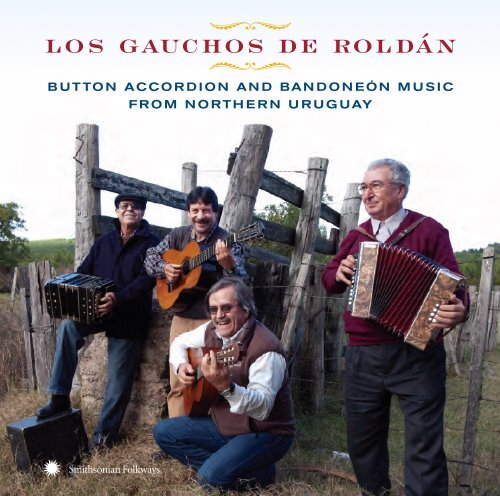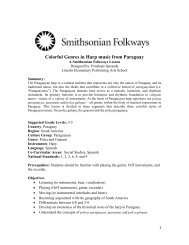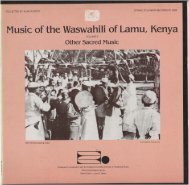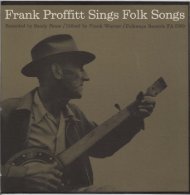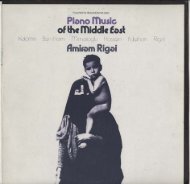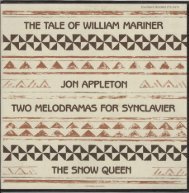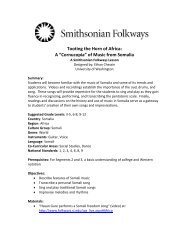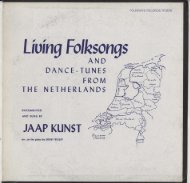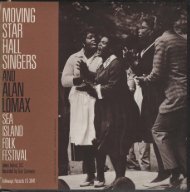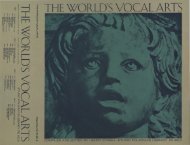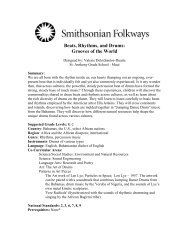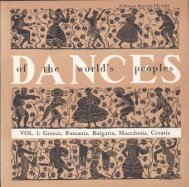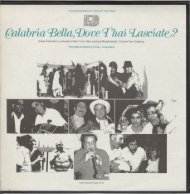4s 4s
4s 4s
4s 4s
Create successful ePaper yourself
Turn your PDF publications into a flip-book with our unique Google optimized e-Paper software.
LOS GAUCHOS DE ROL DÁ N<br />
<strong>4s</strong><br />
<strong>4s</strong><br />
B U T TO N A C C O R D I O N A N D BA N D O N E Ó N M U S I C<br />
F R O M N O R T H E R N U R U G UAY<br />
4 2 s
LOS GAUCHOS DE ROL DÁ N<br />
1. Como mi suegra (Like My Mother-in-Law)<br />
milonga 2:17<br />
(Music: Félix Roldán)<br />
2. La embrujada (The Bewitched Polca)<br />
polca 2:48<br />
(Music: Chichí Vidiella)<br />
3. Chotis de Don Lorenzo (Don Lorenzo’s<br />
Schottische) chotis 3:08<br />
(Music: Walter Roldán. Lyrics: Washington Benavidez)<br />
4. En el galpón (In the Barn) maxixa 2:07<br />
(Music: Félix Roldán)<br />
5. La flor del bañado (The Marsh Flower)<br />
polca 3:48<br />
(Music: Guillermo Castro Duré / Héctor Numa Moraes.<br />
Lyrics: Washington Benavidez)<br />
<strong>4s</strong><br />
<strong>4s</strong><br />
B U T TO N AC C O R D I O N A N D BA N D O N E Ó N M U S I C<br />
F R O M N O RT H E R N U R U G UAY<br />
4 3 s<br />
SFW CD 40561 P C 2011 SMITHSONIAN FOLKWAYS RECORDINGS<br />
6. El gaucho en la pulpería (The Gaucho<br />
in the Bar) mazurca 2:49<br />
(Music: Félix Roldán)<br />
7. El viejo (The Old Schottische) chotis 2:47<br />
(Music: Chichí Vidiella)<br />
8. Como polca suena / La polanquera<br />
(It Sounds like Polca / The Girl from San<br />
Gregorio de Polanco) polca 3:41<br />
(Music: Walter Roldán. Music: collected by Abayubá Rodríguez,<br />
attributed to Segundo Severo Alonso. Lyrics: Washington<br />
Benavidez)<br />
9. Colonia Lavalleja (Lavalleja Township)<br />
habanera 2:52<br />
(Music: Walter Roldán)<br />
10. La polquita de la tuna (The Little Polca<br />
of the Tuna Cactus) polca 3:51<br />
(Music: Héctor Numa Moraes. Lyrics: Washington Benavidez)
11. Chotis cuadrillero (The Quadrille Chotis)<br />
chotis 3:30<br />
(Music: Walter Roldán)<br />
12. Maxixa del pañuelito (The Handkerchief<br />
Maxixa) maxixa 3:03<br />
(Music: Walter Roldán)<br />
13. La infeliz (The Miserable Girl) polca 2:41<br />
(Music: Walter Roldán. Lyrics: Washington Benavidez)<br />
14. El remolino (The Whirlwind)<br />
valseado 2:24<br />
(Music: Walter Roldán)<br />
15. Polca del 1904 (The 1904 Polca)<br />
polca 2:46<br />
(Music: Walter Roldán. Lyrics: Washington Benavidez)<br />
16. La roncadora* (The Growling Polca)<br />
polca 2:41<br />
(Music: Chico Soares de Lima)<br />
17. La chiquita de Buricayupí (The Little Girl<br />
from Buricayupí) polca 2:39<br />
(Music: Chichí Vidiella)<br />
18. Cerro abajo (Downhill) maxixa 2:37<br />
(Music: Walter Roldán)<br />
19. Una noche cualquiera (Any Night)<br />
vals 2:41<br />
(Music: Chichí Vidiella)<br />
All songs published by SADAIC Latin Copyrights Inc. on behalf of AGADU in Uruguay, except where noted with an asterisk.<br />
This project has received federal support from the Latino Initiatives Pool, administered by the Smithsonian Latino Center.<br />
Este proyecto recibió apoyo federal del Fondo 4 para Iniciativas Latinas, sadministrado<br />
por el Centro Latino del Smithsonian.
INTRODUCTION<br />
JOSÉ CU R B E LO<br />
La República Oriental del Uruguay, commonly known as Uruguay, is a South American country<br />
of roughly 3.5 million inhabitants, nestled along the Uruguay River between the southern border<br />
of Brazil and the eastern border of Argentina. Almost half the country’s population lives in the<br />
capital, the port city of Montevideo, and the vast rural areas of the interior, primarily grasslands,<br />
are sparsely populated. Traditionally since the colonial period of the 18th century, the country’s<br />
participation in the world economy has been based on animal and agricultural exports.<br />
Before European incursions in the 17th century, the area was inhabited by Charrúas, Minuans,<br />
and other indigenous groups. Persecution and massacres led to the end of the Charrúas and<br />
Minuans as separate ethnic groups in Uruguay by the 1830s, yet they have many descendants<br />
among today’s population. Other indigenous roots of Uruguay come from the Guaraní, of whom<br />
many arrived in the 18th century, fleeing the destruction of the missions further north, during<br />
conflicts with the Portuguese and the Spanish. The mission Guaraní founded many of Uruguay’s<br />
important cities and towns in the interior, and brought a musical culture influenced by the Jesuits.<br />
Many people were brought in slavery from Africa to the region beginning in the 18th century,<br />
and Montevideo came to be a key port in the introduction of enslaved people to the region. Most<br />
of the Africans who came to Uruguay were from the sub-Saharan regions of Angola, Congo,<br />
Dahomey, and Mozambique. These groups brought musical cultures that became creolized as<br />
the years passed.<br />
From Spain, Uruguay received many groups, including Galicians, Basques, and Canary<br />
Islanders. In the 19th century and into the 20th, there was a massive influx into Uruguay of immigrants<br />
primarily from southern Europe, such as French Basques and Italians, as well as French,<br />
English, Russians, Germans, Swiss, and many other groups. Most of Uruguay’s population<br />
descends from these European immigrants, mainly Spaniards and Italians.<br />
The region north of the Río Negro, which bisects the country, has historically had strong<br />
social and economic links to Brazil. After the Portuguese, and subsequently the Brazilians, had<br />
4 4 2 s<br />
s
Buenos Aires<br />
ARGENTINA<br />
PARAGUAY<br />
Río de La Plata<br />
U r u g u a y R i v e r<br />
Colonia Lavalleja<br />
SALTO RIVERA<br />
Tambores Tacuarembó<br />
Buricayupí<br />
PAYSANDÚ TACUAREMBÓ<br />
Río Negro<br />
URUGUAY<br />
San Gregorio de Polanco<br />
Montevideo<br />
4 s<br />
BRAZIL<br />
A t l a n t i c<br />
O c e a n
invaded and occupied the region currently occupied by Uruguay, in the first half of the 19th<br />
century, many Brazilian landowners, their families, and slaves stayed in the country. Also, many<br />
Brazilian slaves escaped to Uruguay in the 19th century because slavery lasted in Brazil until<br />
1888, while in Uruguay it had officially ended more than forty years earlier.<br />
The northern department of Tacuarembó has been a rural center of the cultural mixing of<br />
indigenous descendants, Afro-Uruguayans, Brazilians, and European immigrants, and a center of<br />
the northern Uruguayan tradition of accordion and bandoneón.<br />
In the mid 19th century, the popular European dance forms of the time—polka, mazurka,<br />
waltz, and schottische—arrived in Uruguay, and according to Uruguayan ethnomusicologist Lauro<br />
Ayestarán, from the dance salons and musical theater of Montevideo, these rhythms made their<br />
way into the rural areas, where they were “reshaped in the style and way of thinking of the paisanos<br />
(rural people),” says Walter Roldán. The principal example of this process is the polca, which<br />
became one of the most important social dance rhythms in rural Uruguay toward the beginning<br />
of the 20th century, developing an original playing style and unique repertoire, especially north of<br />
the Río Negro. These unique regional elements distinguish the northern Uruguayan polca from its<br />
European ancestors and analogous styles in neighboring Brazil and Argentina.<br />
Also arrived was the habanera, a genre that evolved from the blending of European contradance<br />
with African influences in the Caribbean. The genre, then called danza, most notably<br />
took shape in Cuba, with strong French and Afro-Haitian influences. In the great trans-Atlantic<br />
back-and-forth movement and exchange of people, goods, ideas, and cultural expressions, the<br />
danza arrived in Spain (where it was named habanera, from La Habana, or Havana in English)<br />
and other European countries, and subsequently was spread all over the Americas, where it profoundly<br />
influenced the evolution of various national popular musics. It arrived in Uruguay through<br />
the port of Montevideo, brought in part by black sailors arriving from Cuba.<br />
Guitarist Numa Moraes says: “With the great amount of immigration that came to this area<br />
from Europe came the two-row button accordion, and with the accordion many rhythms and musical<br />
forms that became what we call our folklore. . . . The guitar was the other fundamental instrument<br />
that took root in the country. It is a country where the accordion and the guitar are essential,<br />
4 4<br />
s
and the music brought by black people. That music is fundamental, and it has mixed with other of<br />
our forms, and gives a great specialness to the music of our country. It is a very small country, but<br />
it has a great variety in the way of rhythms and colors in its music.”<br />
By the late 19th century, the new creolized couple dances—polca, vals, mazurca, habanera,<br />
and chotis—were displacing the older colonial group dance forms, such as pericón and media<br />
caña, in rural Uruguay. This change was an expression of the changing social dynamics of the<br />
time, fueled by factors such as the advance of the railroad into rural Uruguay, the progressive<br />
modernization of the rural economy, an influx of immigrants from Europe (primarily from Spain and<br />
Italy), and the international commercialization of the industrially manufactured button accordion,<br />
especially by German manufacturers, such as Hohner.<br />
Ayestarán says the diatonic button accordion was introduced<br />
to Uruguay in 1852. It arrived in a one-row form. Later<br />
came a two-row, eight-bass button form, which became the<br />
model preferred by Uruguayan rural musicians. By about 1900,<br />
the more complex bandoneón began to spread through retailers<br />
in Montevideo and the border cities with Argentina. The<br />
bandoneón offered many more harmonic and melodic possibilities,<br />
with seventy-one bi-sonor buttons—like the diatonic button<br />
accordion, in that each individual button produces two different<br />
pitches, depending on whether the musician is pushing or<br />
pulling the bellows. In rural Uruguay, the button accordion and<br />
bandoneón came to be played by men and women of all races<br />
and ethnic backgrounds.<br />
Walter Roldán, born in 1943 and raised in the northern Otilio Roldán<br />
Uruguayan department of Tacuarembó, is an inheritor of a rich,<br />
multigenerational family tradition of accordionists and musicians. His father, accordionist Otilio<br />
Roldán, was born in Puntas de Arerunguá and raised in Colonia Lavalleja, both small rural communities<br />
in the northern department of Salto. “The first songs he learned from my grandmother. . . .<br />
4 5 s
He was born in 1897, and by 1910 at about 13 years old he considered himself an accordionist.<br />
As a child, he left to work on ranches, but he sought work only where there were accordions,<br />
where he knew there was an accordionist working, to be near an accordion, to have the opportunity<br />
to practice because he didn’t own an instrument,” says Walter of his father, who passed<br />
away in 1976.<br />
In addition to polca, habanera, chotis, vals, and mazurca, the maxixa was an important<br />
rhythm in his father’s repertoire. Maxixe (as it is spelled in Brazil) is a musical and dance style<br />
that developed in the late 19th century in Río de Janeiro. Combining European and Afro-Brazilian<br />
elements, it was one of the first urban dance styles of Brazil and a precursor of modern samba.<br />
It enjoyed popularity in Uruguay through sheet music, performance, and recordings, especially<br />
during the late 1920s and early 1930s. “Maxixa was a rhythm that was used a lot in the rural areas<br />
here in Tacuarembó and in Salto because of the influence of Brazil, and on the radio they were<br />
played as well—maxixas on 78 records. My father had many maxixas that he learned from other<br />
accordionists.” Walter adds, “That was the legacy that he left us, the music that he played, and<br />
some songs were perhaps learned from an old 78 record, the kind that used to be used around<br />
here.” He remembers that even until the 1950s a Victrola was used at weekly family dances in his<br />
neighborhood when the families could not find a live musician to play.<br />
THE ARTISTS<br />
Walter Roldán: Born in 1943 in Tacuarembó into a musical clan of eight siblings, at the age of<br />
fifteen Walter began to play on the radio program El viejito del acordeón on Radio Zorrilla in the<br />
city of Tacuarembó. In the 1980s, he began to organize encuentros de acordeones (accordion<br />
festivals), which presented traditional button accordionists from his region. In 1986, he founded<br />
his group, Los Gauchos de Roldán. In 1996, he began to collaborate with Numa Moraes. He has<br />
performed in the United States, Canada, Cuba, Mexico, Argentina, and Brazil.<br />
Luís Alberto “Chichí” Vidiella: Born in 1932 into a musical family in Tres Bocas de Cerro<br />
4 6 s
Walter Roldán (right) and Dante Techera Márquez on the radio<br />
program “El viejito del acordeón”<br />
4 7 s<br />
Chato, Paysandú, Chichí began playing<br />
bandoneón professionally in 1948. For many<br />
decades, he accompanied the legendary<br />
Uruguayan artist Aníbal Sampayo. He has<br />
composed numerous songs in a variety of<br />
styles, ranging from tango to chamamé.<br />
Bernardo Sanguinetti: A guitarist from<br />
Tacuarembó, Bernardo (b. 1962) studied and<br />
performed with influential Uruguayan guitarists<br />
such as Alberto Larriera. He was a key<br />
participant in the vibrant musical scene at El<br />
Bar de Toto, run by the late Tacuarembó popular<br />
guitarist “Toto” Latorre, where he began<br />
to collaborate with Walter Roldán.<br />
Ricardo Cunha: A guitarist and veterinarian<br />
from Tacuarembó, Ricardo (b. 1951) began<br />
to form part of the important traditional music<br />
group Los Aparceros in 1990, playing guitarrón.<br />
In the 1960s, he learned of Walter<br />
Roldán by listening to the radio program El<br />
viejito del acordeón.<br />
Héctor Numa Moraes: Born in 1950 in the town of Curtina, Tacuarembó, Numa is a key guitarist<br />
and singer-songwriter in Uruguayan popular music. He began to collaborate with Walter Roldán<br />
in 1996.
TRACK NOTES<br />
1. Como mi suegra (Like My Mother-in-Law) milonga<br />
Walter Roldán, button accordion; Chichí Vidiella, bandoneón; Ricardo Cunha, guitarrón; Bernardo Sanguinetti, guitar<br />
The title, “Como mi suegra,” was given by Walter’s older<br />
brother Félix to a maxixa melody that was played in the family.<br />
Here it is cast as milonga to showcase that particular<br />
rhythm, also very important in Uruguayan folklore. Milonga is<br />
of late 19th-century Afro-Creole origin in the port cities of<br />
Montevideo and Buenos Aires. It was assimilated into rural<br />
Uruguay and further popularized as urban música típica,<br />
spread via orchestras and recordings in the 20th century.<br />
Before the spread of urban música típica, says Walter, only<br />
maxixa, mazurca, habanera, and other rhythms were danced<br />
in his area of rural northern Uruguay.<br />
2. La embrujada (The Bewitched Polca) polca<br />
Walter Roldán, button accordion; Chichí Vidiella, bandoneón; Ricardo<br />
Cunha, guitarrón and vocals; Bernardo Sanguinetti, guitar<br />
Félix Roldán<br />
In rural northern Uruguay, dances were traditionally played<br />
by just one accordion, or later, one bandoneón. Very seldom was the music played by two<br />
instruments at once, as featured on this album. Walter’s older brother Félix Roldán (b. 1932)<br />
remembers, “By chance it only happened in get-togethers among musicians . . . [but] playing<br />
dances with accordion and bandoneón, no.” This reflects the strong individualism of rural<br />
Uruguayan music, as well as the low population density of the rural north.<br />
Walter recalls, “it was very common that rural musicians, in order to expand their repertoire,<br />
4 8 s
would travel many kilometers on horseback [to dances], but not to dance. They went to spend<br />
the night listening to the music, and sometimes would return with some melodies in their heads.<br />
They tried to memorize them, and as they returned home, it could be many kilometers before they<br />
got home to try out the songs. . . . They would listen, and later go to their homes and grab their<br />
instruments and try to repeat what they had heard. Many times they would mix a part of one song<br />
with another, but that was the musical tradition; that’s the way it was.”<br />
“La embrujada,” a composition by Chichí Vidiella, showcases the unique pairing of his bandoneón<br />
and the button accordion of Walter Roldán.<br />
3. Chotis de Don Lorenzo (Don Lorenzo’s Schottische) chotis<br />
Walter Roldán, button accordion; Chichí Vidiella, bandoneón; Ricardo Cunha, guitarrón; Bernardo Sanguinetti, guitar;<br />
Héctor Numa Moraes, guitar and lead vocals<br />
Walter recalls that Lorenzo Díaz was a “unique character because he had a long white beard and<br />
long hair down to his back. He played accordion and guitar. He had a reputation for being bad<br />
and sometimes would steal away women and take them to his shack. . . . [He] generally worked<br />
in sheep shearing. My dad would always be there with his cart and merchandise to sell to the<br />
peones [rural workers]. When the work was done, the peones would prepare mate [traditional<br />
regional tea drink], and my dad would play the accordion and a dance would start. After the dance<br />
was over and everyone went to sleep, [Lorenzo] would borrow my dad’s accordion and begin to<br />
create things: polcas, chotis, valses, . . . as they came out of his head.”<br />
The white beard to his chest and his patriarchal mane: / it was an image of the Banda<br />
Oriental,* / but beware the young woman who should hear his accordion; / to her own<br />
demise, the seducer would steal her away.<br />
*Historical name for the region east of the Uruguay River and north of the Río de la Plata.<br />
4 9<br />
s
4. En el galpón (In the barn) maxixa<br />
Walter Roldán, button accordion; Chichí Vidiella, bandoneón; Ricardo Cunha, guitarrón; Bernardo Sanguinetti, guitar<br />
This maxixa, a preferred dance song in the Roldán family, was given its name by Walter’s older<br />
brother Félix in the 1960s or 1970s.<br />
5. La flor del bañado (The Marsh Flower) polca<br />
Walter Roldán, button accordion; Chichí Vidiella, bandoneón; Ricardo Cunha, guitarrón; Bernardo Sanguinetti, guitar and<br />
vocals; Héctor Numa Moraes, guitar and lead vocals<br />
“That is probably the most famous polca of the country” says influential Uruguayan poet<br />
Washington Benavidez of “La Flor del Bañado,” who put lyrics to this melody, attributed to<br />
blind Tacuarembó accordionist Guillermo Duré. “What often happens is that instrumental music<br />
does not get the recognition that it gets if it has lyrics,” said Benavidez about traditional northern<br />
Uruguayan accordion dance music, which has been historically strictly instrumental. Benavidez,<br />
in collaboration with Numa Moraes and Walter Roldán, has over the years given lyrics to many<br />
traditional accordion dance melodies.<br />
“The Marsh Flower” / they call this polca in Curtina, / and the name is well-earned / for<br />
its beauty and wildness.<br />
6. El gaucho en la pulpería (The Gaucho in the Bar) mazurca<br />
Walter Roldán, button accordion; Chichí Vidiella, bandoneón; Ricardo Cunha, guitarrón; Bernardo Sanguinetti, guitar<br />
This mazurca was also part of the Roldán family repertoire. Otilio Roldán told Walter how he<br />
used to see the mazurca danced in his youth with a bastonero (dance caller), who would lead<br />
the couples in dance figures, harking back to the old colonial forms of pericón and media caña.<br />
Mazurca was one of the rhythms that Otilio learned from his mother, an accordionist in the late<br />
19th century in rural Salto.<br />
4 10 s
7. El viejo (The Old Schottische) chotis<br />
Walter Roldán, button accordion; Chichí Vidiella, bandoneón; Ricardo Cunha, guitarrón; Bernardo Sanguinetti, guitar<br />
“In those days, my grandma would tell me they played polcas, chotis, valses. Tango didn’t even<br />
exist at that time. In the interior, polcas and that kind of thing were always played on the bandoneón<br />
[even though] people think that the bandoneón is more for tango than anything else,”<br />
explains Chichí, remembering his grandmother Celestina Silva, who played button accordion.<br />
8. Como polca suena / La polanquera (It Sounds like Polca / The Girl from San Gregorio de<br />
Polanco) polca<br />
Walter Roldán, button accordion; Chichí Vidiella, bandoneón; Ricardo Cunha, guitarrón and vocals;<br />
Bernardo Sanguinetti, guitar and vocals<br />
“Como polca suena” was learned by Walter from Tacuarembó rancher and accordionist Edgardo<br />
“Pirulo” Martínez, father of the accordionists of the group Los Aparceros. “La polanquera” is a<br />
polca collected by the late master bandoneonist Abayubá Rodríguez from button accordionist<br />
Segundo Severo Alonso, both from Tacuarembó.<br />
Abayubá reflects, “The bandoneón is beautiful for its expressions, the sonority of the instrument<br />
adapted very well to the environment in which we live. When I heard a bandoneón for the<br />
first time, I was a boy living in the country, where I only knew the sounds of the countryside: the<br />
birds, the animals, the calves calling for their mothers. The first time I heard [a bandoneón], to me<br />
in its sound, all of that was represented.”<br />
9. Colonia Lavalleja (Lavalleja Township) habanera<br />
Walter Roldán, button accordion; Chichí Vidiella, bandoneón; Ricardo Cunha, guitarrón and vocals;<br />
Bernardo Sanguinetti, guitar and vocals<br />
This song Walter has played since his youth and is one of the “songs that my father played, . . . (a)<br />
habanera from the 19th century. We named it “Colonia Lavalleja” because that is the area where<br />
4 11 s
he was raised. He saw how the habanera was danced and it had its own form. When a dancer<br />
would request, ‘Play me a habanera,’ my father would ask, ‘How are you going to dance it?’ and<br />
the dancer would say, ‘a la moda de Lavalleja, media vuelta y a la oreja’ (the Lavalleja style, one<br />
time around, and talk to her). What did that mean? That they would go out on the dance floor,<br />
go around it once, and then the guy would begin to talk to the girl in her ear. That was the way to<br />
enamor the girl. The habanera was a slow dance so that they could converse in peace.”<br />
10. La polquita de La Tuna (The Little Polca of La Tuna) polca<br />
Walter Roldán, button accordion; Chichí Vidiella, bandoneón; Ricardo Cunha, guitarrón; Bernardo Sanguinetti, guitar;<br />
Héctor Numa Moraes, guitar and lead vocals<br />
“‘La polquita de La Tuna’ is on the one hand a re-creation of an area of the department of<br />
Tacuarembó, La Tuna, that is beautiful, with gorges and grottos, and woods. . . . And on the other<br />
hand [it tells] Numa’s story,” says lyricist Washington Benavidez. The lyrics allude to the composer’s<br />
youth and musical development in Tacuarembó, as well as his exile during the period of<br />
dictatorship (1973 to 1985) in Uruguay.<br />
Like beads on a creole rosary, / the flock descended, / and a mirlo* was visible by its<br />
song / from a green anacahuita.°<br />
The horror passed / of a cruel time. / The tuna cactus gave its honey-sweet prickly<br />
pear. / Light returned to my country, / although not everything was happy.<br />
*A regional bird, known for its song.<br />
°A native tree, known for its medicinal properties.<br />
11. Chotis cuadrillero (The Quadrille Chotis) chotis<br />
Walter Roldán, button accordion; Chichí Vidiella, bandoneón; Ricardo Cunha, guitarrón; Bernardo Sanguinetti, guitar<br />
4 12 s
This chotis was also in Otilio Roldán’s repertoire, and was played by all the Roldán brothers.<br />
Chotis was an important rhythm in the dances of Otilio’s day in northern Uruguay, where a mix<br />
of Portuguese and Spanish (Portuñol) predominated in the rural areas. Couples had many varied<br />
dance steps and figures for the chotis.<br />
12. Maxixa del pañuelito (The Handkerchief Maxixa) maxixa<br />
Walter Roldán, button accordion; Chichí Vidiella, bandoneón; Ricardo Cunha, guitarrón; Bernardo Sanguinetti, guitar<br />
This maxixa was in Otilio Roldán’s dance repertoire. Walter gave it its name “Maxixa del pañuelito”<br />
(The Handkerchief Maxixa) because in the dances that his father played, the dancers would wear<br />
their best clothes, and when a boy would get a girl to dance with him, he would cover his hand<br />
with a handkerchief so as not to stain the girl’s dress with perspiration.<br />
13. La Infeliz (The Miserable Girl) polca<br />
Walter Roldán, button accordion; Chichí Vidiella, bandoneón; Ricardo Cunha, guitarrón; Bernardo Sanguinetti, guitar<br />
and vocals; Héctor Numa Moraes, guitar and lead vocals<br />
This polca was played in the rural border area between the departments of Tacuarembó and<br />
Paysandú. Walter learned it from bandoneonist “El Negro” Díaz in the town of Tambores,<br />
Tacuarembó in the 1970s.<br />
Numa Moraes observed that the polcas from northern Uruguay “often are in minor keys,<br />
which give them great joyfulness but at the same time a depth; there are very deep things that<br />
emanate from the dancer or the musician.”<br />
Could it be her mother, / who has passed away, / leaving her / in loneliness? / Or her<br />
father died, / or a brother / is lost and far away? / Life has many mysteries / and serious<br />
things to discover.<br />
4 13 s
14. El remolino (The Whirlwind) valseado<br />
Walter Roldán, button accordion; Chichí Vidiella, bandoneón; Ricardo Cunha, guitarrón; Bernardo Sanguinetti, guitar<br />
The rhythms of the dances of Otilio’s day were never played very fast. This valseado, in contrast,<br />
named later “El remolino” by Walter, was always played fast by Otilio, causing the spinning waltz<br />
movements of the dancers to resemble a whirlwind. Fast valses are generally called valseados.<br />
This song Otilio heard played by Lorenzo Díaz.<br />
15. Polca del 1904 (The 1904 Polca) polca<br />
Walter Roldán, button accordion; Chichí Vidiella, bandoneón; Ricardo Cunha, guitarrón; Bernardo Sanguinetti, guitar;<br />
Héctor Numa Moraes, guitar and lead vocals<br />
The melody of this song was composed by Walter Roldán, and Washington Benavidez’s lyrics<br />
tell of a period in Uruguay’s history that saw several internal armed conflicts between two of the<br />
main political parties: the Colorados, historically associated with urban and immigrant interests<br />
of Montevideo, and the Blancos, historically associated with the rural interior and landowners’<br />
interests. The song tells of El Negro Fando, a soldier in the Battle of Masoller in 1904, one of the<br />
bloodiest of the clashes.<br />
Benavidez recalls, “El Negro Fando was an assistant of Colonel Marcelino Benavidez, my<br />
grandfather, one of the victors at Masoller.” Taken prisoner, “Fando was left for dead with his throat<br />
cut, . . . but he survived.” Afterward, at every anniversary of the battle, Fando would stand outside<br />
his old colonel’s window and salute him.<br />
Washington Benavidez had met El Negro Fando. In writing the lyrics, he aimed to “draw<br />
attention to the regular people who were risking their lives,” as well as allude to “faithfulness, manhood,<br />
brotherhood, and friendship,” as opposed to the “glorification of war.”<br />
And this polca has no factions, no colors: / It only remembers El Negro Fando for his<br />
honor. / Also think of the men from the country and the city / who for friendship or for<br />
their flag fought without complaint.<br />
4 14 s
16. La roncadora (The Growling Polca) polca<br />
Walter Roldán, button accordion; Chichí Vidiella, bandoneón; Ricardo Cunha, guitarrón and vocals, Bernardo<br />
Sanguinetti, guitar and vocals<br />
The composer of this polca, accordionist Chico Soares de Lima, lived in the northern department<br />
of Rivera, bordering Brazil, and was a member of a large clan of musicians important in Uruguayan<br />
folklore, the Soares de Lima Medeiros. Walter says, “When I met Chico Soares, the song of his<br />
that I liked the best was this one. I was very young and I didn’t have the ability to play it, but it was<br />
stored in my head. Many years passed until I had enough ability on the accordion to play this polca<br />
as he did.” In this way, Walter’s incredible musical memory has preserved many songs of popular<br />
accordionists of northern Uruguay.<br />
17. La chiquita de Buricayupí (The Little Girl from Buricayupí) polca<br />
Chichí Vidiella, bandoneón; Ricardo Cunha, guitarrón<br />
Buricayupí is a small rural village near Tres Bocas de Cerro Chato,<br />
the town where Chichí was born, in the northern department of<br />
Paysandú. Chichí’s uncles played this song.<br />
On this rendition with only bandoneón and guitarrón, the distinctive<br />
manner of accompaniment can be perceived in Ricardo<br />
Cunha’s playing. “The way of playing that I saw in guitarists in the<br />
countryside [was a] percussive way of playing. In addition to playing<br />
the strings, [they strummed] in a form that the guitar served as<br />
element of percussion as well. The guitarists who accompanied<br />
accordions always played in that way,” says Cunha.<br />
Guitarrón made by Montevideo luthier Luís Eduardo Miranda<br />
4 15 s
The guitarrón in Uruguay is a classical guitar, with a slightly larger and deeper body and a<br />
lower tuning. The guitarrón that Ricardo plays is a regular classical guitar, tuned lower, to B–E–<br />
A–D–F#–B. Ricardo’s unique style is an application of the traditional regional percussive guitar<br />
techniques to the deeper guitarrón. The guitarrón, arriving through the influence of Argentine<br />
tango guitarists, has been utilized for several decades in numerous Uruguayan tango and traditional<br />
guitar ensembles.<br />
18. Cerro abajo (Downhill) (maxixa)<br />
Walter Roldán, button accordion; Ricardo Cunha, guitarrón; Bernardo Sanguinetti, guitar<br />
The maxixa “Cerro abajo” was in Otilio Roldán’s repertoire. Walter learned it when he was a child.<br />
His father named it “Cerro abajo” (Downhill) for the sensation of falling downhill given by the first<br />
section of the music.<br />
19. Una noche cualquiera (Any Night) (vals)<br />
Walter Roldán, button accordion; Chichí Vidiella, bandoneón; Ricardo Cunha, guitarrón; Bernardo Sanguinetti, guitar<br />
This song showcases the bandoneón of<br />
Chichí Vidiella, on a beautiful vals of his<br />
own composition.<br />
Chichí Vidiella (left) and friend Alberto Bonino, c. 1965<br />
4 16 s
NOTA S EN ESPAÑOL<br />
INTRODUCCIÓN<br />
JOSÉ CU R B E LO<br />
La República Oriental del Uruguay, conocida comúnmente como Uruguay, es un país sudamericano<br />
de aproximadamente 3.5 millones de habitantes, que se extiende a lo largo del Río Uruguay,<br />
entre la frontera sur de Brasil y la frontera este de Argentina. Casi la mitad de la población del país<br />
vive en la capital, la ciudad puerto de Montevideo, y el extenso territorio del interior, constituido<br />
principalmente de pastizales, tiene menos concentración de habitantes. Tradicionalmente, desde<br />
la época colonial del siglo XVIII, la participación del país en la economía mundial se ha basado<br />
mayormente en exportaciones agropecuarias.<br />
Antes de las invasiones europeas del siglo XVII, el área estuvo habitada por los Charrúas,<br />
Minuanes, y otros grupos indígenas. Debido a años de persecución y masacres, los Charrúas y<br />
Minuanes se terminaron como colectividades étnicas en los años 1830, aunque existen muchos<br />
descendientes en la población actual del Uruguay. Otras raíces indígenas del Uruguay vienen de<br />
los Guaraní, muchos de los cuales llegaron en el siglo XVIII huyendo de la destrucción de las<br />
misiones de más al norte, durante los conflictos con los portugueses y españoles. Los guaraníes<br />
misioneros fueron fundadores de muchos de los pueblos y ciudades importantes del interior de<br />
Uruguay y trajeron con ellos una cultura musical influenciada por los jesuitas.<br />
Mucha gente fue traída en esclavitud desde África a principios del siglo XVIII, y Montevideo<br />
llegó a ser un punto clave para la introducción de gente esclavizada a la región. La mayoría de<br />
los africanos que llegaron al Uruguay provenían de las regiones de África sub-sahariana de<br />
Angola, Congo, Dahomey, y Mozambique. Estos grupos trajeron sus culturas musicales que con<br />
el tiempo se “acriollaron”.<br />
De España, Uruguay recibió muchos grupos como gallegos, vascos y canarios. En los<br />
siglos XIX y XX hubo una ola masiva de inmigrantes principalmente del sur de Europa, como<br />
vascos franceses e italianos, tanto como franceses, ingleses, rusos, alemanes, suizos, y muchos<br />
4 17 s
Clockwise from top left: Walter Roldán, Dance at the Agremiación de Pasivos<br />
19 de Junio in the city of Tacuarembó, Ricardo Cunha, Chichí Vidiella’s AA<br />
Brand Bandoneón<br />
4 s
Clockwise from top left: Bernardo Sanguinetti, Chichí Vidiella,<br />
musicians at Walter Roldán’s home, Héctor Numa Moraes<br />
4 s
otros grupos. La mayoría de la población de Uruguay desciende de inmigrantes europeos,<br />
principalmente españoles e italianos.<br />
Históricamente, la región al norte del Río Negro que divide al país, ha tenido fuertes lazos<br />
sociales y económicos con Brasil. En la primera mitad del siglo XIX, después que los portugueses<br />
y luego los brasileños invadieron y ocuparon el territorio que conforma a Uruguay de hoy en<br />
día, muchos terratenientes brasileños permanecieron en el país con sus familias y sus esclavos.<br />
También, en el siglo XIX muchos esclavos brasileños se fugaron a Uruguay, dado que la esclavitud<br />
como institución que se mantuvo en Brasil hasta 1888, mientras que en Uruguay se había<br />
abolido oficialmente cuarenta años antes.<br />
El departamento norteño de Tacuarembó ha sido un epicentro rural de la mezcla cultural<br />
entre descendientes de indígenas, afro-uruguayos, brasileños, e inmigrantes europeos. También<br />
ha sido un centro de la tradición de acordeón y bandoneón del norte de Uruguay.<br />
A mediados del siglo XIX los ritmos de moda en Europa de la época—polka, mazurka, waltz,<br />
y schottische—llegaron al Uruguay, y según el etnomusicólogo Lauro Ayestarán, de los salones y<br />
teatros de Montevideo esta música se iba difundiendo a las zonas rurales y “fue media hecha a la<br />
forma o el estilo, a la forma de pensar de los paisanos” de acuerdo a Walter Roldán. El principal<br />
ejemplo de este proceso es la polca, que logró ser uno de los ritmos más importantes para el<br />
baile social en el interior de Uruguay a principios del siglo XX, desarrollando un estilo original<br />
de interpretación, y un repertorio único, especialmente al norte del Río Negro. Estos elementos<br />
regionales únicos diferencian a la polca del norte de Uruguay de estilos europeos ancestrales y<br />
de estilos emparentados en los países vecinos de Argentina y Brasil.<br />
También llegó la habanera, un género que evolucionó del mestizaje de la contradanza europea<br />
con influencias africanas en el Caribe. El género, llamado anteriormente danza, se desarrolló<br />
notablemente en Cuba con fuertes influencias francesas y afro-haitianas. En el gran movimiento<br />
de ir y venir, e intercambio de gente, bienes, ideas, y expresiones culturales que atravesaba al<br />
Océano Atlántico, la danza llegó a España (donde fue bautizada habanera, de La Habana) y a otros<br />
países europeos, y de ahí se difundió por el continente americano, donde tuvo una influencia<br />
profunda en la evolución de las músicas populares de varias naciones. Llegó al Uruguay a través<br />
4 20 s
del puerto de Montevideo, en parte traída por marineros negros provenientes de Cuba.<br />
El guitarrista Numa Moraes dice: “Con la gran cantidad de inmigración que vino a esta<br />
zona de Europa, ahí llegó el acordeón de doble hilera, y con el acordeón una cantidad de ritmos<br />
y formas musicales que se hicieron y que son lo que nosotros llamamos nuestro folklore. . . . La<br />
guitarra fue el otro instrumento fundamental que se arraigó en el país. . . . Es un país en [el] cual el<br />
acordeón y la guitarra son fundamentales, y después la música traída por los negros esclavos. . . .<br />
Esa música es fundamental y se ha mezclado con las otras formas nuestras, y . . . da una particularidad<br />
a la música de nuestro país muy grande. Es un país muy chiquito pero tiene una gran<br />
variedad en cuanto a ritmos, en cuanto a colores en su música”.<br />
A finales del siglo XIX, los bailes “acriollados” de pareja como polca, vals, mazurca, habanera,<br />
y chotis iban desplazando a las formas coloniales más antiguas como pericón, y media caña<br />
en las zonas rurales de Uruguay. Este cambio fue una expresión de la dinámica social cambiante<br />
de la época, alimentada por el avance del ferrocarril al interior de Uruguay, la progresiva modernización<br />
de la economía rural, el gran flujo de inmigrantes de Europa (principalmente de España<br />
e Italia), y la fabricación industrial y comercialización internacional de los acordones de botón,<br />
especialmente por compañías alemanas como Hohner.<br />
Ayestarán afirma que 1852 fue la fecha en que el acordeón de botón fue introducido al<br />
Uruguay. Estaba compuesto de una hilera de botones. Más tarde llegó la versión de dos hileras<br />
de botones y ocho bajos, que se convirtió en el modelo preferido por los músicos rurales de<br />
Uruguay. A principios del siglo XX el bandoneón—de mayor complejidad—empezó a difundirse por<br />
medio de tiendas y casas de música en Montevideo y en las ciudades limítrofes con la Argentina.<br />
El bandoneón brindaba más posibilidades armónicas y melódicas, con setenta y un botones<br />
bisonoros, que como con el acordeón de botón, cada botón individual produce dos tonos distintos<br />
según si el músico esté cerrando o abriendo el fuelle. En las zonas rurales del Uruguay, el<br />
acordeón de botón y el bandoneón los tocaban hombres y mujeres de todas las razas y etnias.<br />
Walter Roldán, nacido en 1943, se crió en el departamento norteño de Tacuarembó, y es<br />
heredero de una rica tradición familiar multi-generacional de acordeonistas y músicos. Su padre,<br />
Otilio Roldán, nació en Puntas de Arerunguá y se crió en Colonia Lavalleja, ambas pequeñas<br />
4 21 s
comunidades rurales en el departamento norteño de Salto. Walter Roldán cuenta lo siguiente de<br />
su padre que falleció en 1976: “Los primeros temas aprendió con la abuela . . . porque él nació<br />
en 1897, pero en 1910 ya tal vez con trece años él ya se consideraba un acordeonista, porque él<br />
salió a trabajar muy joven porque antes no estudiaba, porque mi padre no fue a la escuela, muy<br />
niño ya salió a trabajar en estancias, pero él buscaba trabajo sólo donde habían acordeones, que<br />
sabía que había algún acordeonista trabajando allí para estar cerca de un acordeón para tener la<br />
oportunidad de practicar porque él en si no tenía instrumento.”<br />
Además de la polca, habanera, chotis, vals, y mazurca, la maxixa fue un ritmo importante<br />
en el repertorio de su padre. Maxixe (como se escribe en Brasil) es un estilo de música y baile<br />
que se desarrolló a finales del siglo XIX en Río de Janeiro. Combina elementos europeos y afrobrasileños,<br />
y fue uno de los primeros estilos populares urbanos de baile en Brasil y precursor<br />
de la samba moderna. Tuvo auge en Uruguay a través de partituras, actuaciones, y grabaciones,<br />
especialmente a finales de la década de 1920 y a principios de la década de 1930. “La maxixa . . .<br />
era un ritmo que se usaba mucho en la campaña acá de Tacuarembó y de Salto por la influencia<br />
de Brasil…incluso en las radios acá. . . . Se difundía la maxixa en discos de 78. . . . Mi padre tenía<br />
muchas maxixas que él recopilaba de otros acordeonistas”. Agrega Walter, “Esos temas son toda<br />
una tradición, fue la herencia que nos dejó, esa música que él tocaba . . . y muchas tal vez fueron<br />
sacadas del algún disco 78 de aquellos muy antiguos por que antes se usaba acá.” Él se acuerda<br />
que hasta la década de 1950 se solía usar una Victrola en los bailes familiares de su barrio en<br />
Tacuarembó cuando las familias no podían encontrar un músico para tocar en vivo.<br />
LOS ARTISTA S<br />
Walter Roldán. Nació en 1943 en Tacuarembó en una familia musical de ocho hermanos. A los<br />
quince años Walter comenzó a tocar en el programa “El viejito del acordeón” por Radio Zorrilla<br />
en la ciudad de Tacuarembó. En la década de 1980 empezó a organizar “encuentros de acordeones”<br />
que reunían acordeonistas de dos hileras de su región. En 1986 fundó a su conjunto, Los<br />
Gauchos de Roldán. En 1996 comenzó su colaboración artística con Numa Moraes. Walter se ha<br />
4 22 s
presentado en los Estados Unidos, Canadá, Cuba, México, Argentina, y Brasil.<br />
Encuentro de Acordeones an annual event organized by Walter Roldán (second from the right) which gathered traditional button accordionists<br />
from the region (1987, Tacuarembó)<br />
4 23 s
Luís Alberto “Chichí” Vidiella. Nació en 1932 en una familia musical en Tres Bocas de Cerro<br />
Chato, Paysandú. Chichí inició su carrera de bandoneonista profesional en 1948. Por muchas<br />
décadas acompañó al artista uruguayo legendario, Aníbal Sampayo. Chichí es autor de numerosas<br />
composiciones en estilos diversos desde el tango al chamamé<br />
Bernardo Sanguinetti. Guitarrista de Tacuarembó, Bernardo nació en 1962 y estudió con<br />
guitarristas influyentes como Alberto Larriera. Bernardo fue un participante clave en el ambiente<br />
artístico del “Bar de Toto”, boliche del ya fallecido guitarrero popular de Tacuarembó, “Toto”<br />
Latorre, donde empezó su colaboración con Walter Roldán.<br />
Ricardo Cunha. Guitarrero y veterinario de Tacuarembó, Ricardo nació en 1951, y empezó a<br />
integrar al importante conjunto tradicional Los Aparceros en 1990 tocando el guitarrón. En la<br />
década de 1960, conoció a Walter Roldán escuchando la emisión radial “El viejito del acordeón”.<br />
Héctor Numa Moraes. Guitarrista y cantautor, nacido en el pueblo de Curtina, Tacuarembó en<br />
1950, Numa es una figura clave en la música popular uruguaya. Empezó a colaborar artísticamente<br />
con Walter Roldán en 1996.<br />
NOTA S DE LA S PISTA S<br />
1. Como mi suegra (milonga)<br />
Walter Roldán, acordeón de botón; Chichí Vidiella, bandoneón; Ricardo Cunha, guitarrón; Bernardo Sanguinetti, guitarra<br />
“Como mi suegra,” una melodía de maxixa que siempre se tocó en la familia Roldán, fue bautizada<br />
así por Félix, el hermano mayor de Walter. En esta versión se interpreta como milonga para<br />
destacar la importancia de este ritmo en el folklore musical uruguayo. La milonga tiene orígenes<br />
afro-criollos del siglo XIX de los puertos de Buenos Aires y Montevideo. Se difundió al interior<br />
de Uruguay y se popularizó aún más con el auge de la música típica urbana en el siglo XX por<br />
4 24<br />
s
medio de orquestas y grabaciones. Según Walter Roldán, antes de la entrada de la música típica,<br />
solamente se bailaban ritmos como maxixa, mazurca, habanera en las regiones rurales del norte<br />
de Uruguay.<br />
2. La embrujada (polca)<br />
Walter Roldán, acordeón de botón; Chichí Vidiella, bandoneón; Ricardo Cunha, guitarrón y voz;<br />
Bernardo Sanguinetti, guitarra<br />
Típicamente, en las regiones rurales del norte de Uruguay los bailes eran animados por un solo<br />
acordeón, o más tarde un solo bandoneón. Rara vez se tocaban los dos instrumentos juntos en<br />
un baile, como se presenta en este álbum. El hermano mayor de Walter, Félix Roldán (nacido en<br />
1932), recuerda, “Por casualidad se dio en reuniones entre músicos no más, . . . (pero) hacer<br />
bailes con acordeón de dos hileras y bandoneón, no”. Este hecho refleja el carácter individualista<br />
de la música rural uruguaya, y también la baja densidad poblacional del norte uruguayo rural.<br />
Walter recuerda que “era muy común que los músicos de campaña (rurales) para ampliar<br />
el repertorio, salían, se iban muchos kilómetros de a caballo (a los bailes) y no iban a bailar. Iban<br />
a pasar la noche escuchando a la música, y a veces se venían con algunos temas en la mente<br />
ahí. Trataban de memorizarlos y venían a su casa, puede ser otros tantos kilómetros para atrás<br />
para sacarlos. Escuchaban y después se iban a sus casas, agarraban el instrumento y trataban de<br />
repetir lo que habían escuchado. Que muchas veces mezclaban una parte de un tema con otro,<br />
pero era la tradición musical, eso era lo que había”.<br />
En “La embrujada,” composición de Chichí, se destaca la combinación especial del bandoneón<br />
de Vidiella con el acordeón de Walter Roldán.<br />
3. Chotis de Don Lorenzo (chotis)<br />
Walter Roldán, acordeón de botón; Chichí Vidiella, bandoneón; Ricardo Cunha, guitarrón;<br />
Bernardo Sanguinetti, guitarra; Héctor Numa Moraes, guitarra y canto<br />
Walter recuerda que Lorenzo Díaz era “un personaje muy pintoresco porque usaba una barba lar-<br />
4 25 s
ga, usaba una melena media espalda . . . y tocaba el acordeón y tocaba la guitarra . . . Tenía infame<br />
de malo, y a veces se robaba a alguna china, se la traía para el rancho . . . Pero ese personaje<br />
estaba generalmente en la esquila, iba a la esquila, mi padre siempre andaba con carro y mercadería<br />
para venderles a los peones rurales . . . Cuando terminaba el día de trabajo los peones preparaban<br />
su mate y mi padre a tocar el acordeón, entonces se armaba el baile. Después que había<br />
terminado todo el baile, y se iban a acostar, él le pedía el acordeón prestado a mi padre, y Lorenzo<br />
empezaba a crear cosas . . . polcas, chotis, y valses . . . que iban saliendo de la cabeza de él”.<br />
La barba blanca al pecho y la melena patriarcal: / era una aparición de la Banda<br />
Oriental,* / pero guarda la moza que escuchara su acordeón; / para su perdición la<br />
alzaba el seductor.<br />
*Nombre histórico de la región al este del Río Uruguay y al norte del Río de la Plata.<br />
4. En el galpón (maxixa)<br />
Walter Roldán, acordeón de botón; Chichí Vidiella, bandoneón; Ricardo Cunha, guitarrón; Bernardo Sanguinetti, guitarra<br />
Esta maxixa, un tema preferido para baile de los Roldán, fue bautizado “En el galpón” por el hermano<br />
mayor de Walter, Félix, en la década de 1960 ó 1970.<br />
5. La flor del bañado (polca)<br />
Walter Roldán, acordeón de botón; Chichí Vidiella, bandoneón; Ricardo Cunha, guitarrón;<br />
Bernardo Sanguinetti, guitarra y canto; Héctor Numa Moraes, guitarra y canto<br />
“Bueno, esa debe ser la polca más famosa del país” manifiesta el poeta uruguayo Washington<br />
Benavidez de “La flor del bañado”, quien puso letra a esta melodía atribuida al acordeonista ciego<br />
Guillermo Duré, de Tacuarembó. “Lo que pasa es que muchas veces la música solamente instrumental<br />
no alcanza la proyección que pueda alcanzar si tiene texto”, dice Benavidez de música<br />
tradicional de acordeón del norte de Uruguay, que históricamente siempre era exclusivamente<br />
4 26 s
instrumental. Benavidez, en colaboración con Numa Moraes y Walter Roldán, han puesto letra a<br />
muchas melodías tradicionales de acordeón.<br />
“Flor del bañado” llaman / a esta polca en Curtina, / y el nombre está bien puesto, /<br />
por hermosa y arisca.<br />
6. El gaucho en la pulpería (mazurca)<br />
Walter Roldán, acordeón de botón; Chichí Vidiella, bandoneón; Ricardo Cunha, guitarrón; Bernardo Sanguinetti, guitarra<br />
Esta mazurca también forma parte del repertorio de la familia Roldán. Otilio Roldán contaba a<br />
Walter como él veía bailar la mazurca en su juventud con bastonero dirigiendo a las parejas en<br />
figuras como en los bailes coloniales de pericón y media caña. Mazurca fue uno de los ritmos<br />
que Otilio aprendió de su madre, una acordeonista en el siglo XIX en las zonas rurales de Salto.<br />
7. El viejo (chotis)<br />
Walter Roldán, acordeón de botón; Chichí Vidiella, bandoneón; Ricardo Cunha, guitarrón; Bernardo Sanguinetti, guitarra<br />
“En aquel tiempo me contaba mi abuela que ellos tocaban polcas, chotis, valses. El tango ni<br />
existía en aquella época. . . . En el interior siempre se tocó polcas y de todo con el bandoneón<br />
[aunque] la gente piensa que el bandoneón es más para tango que para cualquier otra cosa”,<br />
explica Chichí, recordando a su abuela Celestina Silva, quien tocaba el acordeón de botón.<br />
8. Como polca suena / La polanquera (polca)<br />
Walter Roldán, acordeón de botón; Chichí Vidiella, bandoneón; Ricardo Cunha, guitarrón y voz;<br />
Bernardo Sanguinetti, guitarra y voz<br />
Walter aprendió “Como polca suena” del estanciero y acordeonista Edgardo “Pirulo” Martínez,<br />
padre de los acordeonistas del conjunto Los Aparceros. “La polanquera” es una polca recopilada<br />
por el ya desaparecido bandoneonista Abayubá Rodríguez del acordeonista popular Segundo<br />
4 27 s
Severo Alonso, ambos de Tacuarembó.<br />
Abayubá manifesta, “El bandoneón es muy bonito por sus expresiones; la sonoridad del instrumento<br />
se adaptaba muy bien al medio en que vivimos nosotros. . . . Cuando escuché al primer<br />
bandoneón cuando yo era un niño campesino, donde conocía nada más que el ruido del campo,<br />
las aves, el canto, los animales, el balar de los terneros llamando a las madres. Eso me representó,<br />
primera vez que lo escuché (el bandoneón), tal cual como me estaba pintando aquello.”<br />
9. Colonia Lavalleja (habanera)<br />
Walter Roldán, acordeón de botón; Chichí Vidiella, bandoneón; Ricardo Cunha, guitarrón y voz;<br />
Bernardo Sanguinetti, guitar y voz<br />
Walter tocó este tema desde niño y es uno de los “temas que tocaba mi padre . . . (una) habanera<br />
. . . del siglo XIX. Nosotros le pusimos el nombre “Colonia Lavalleja” a esa habanera porque<br />
justamente en esa zona donde él fue criado ahí. Él veía como se bailaba la habanera y tenía su<br />
forma de bailar. Cuando le pidieron la habanera<br />
él le pedía, él le preguntaba “a ver, músico . . . ”,<br />
decía el bailarín, “tócame una habanera” y mi<br />
padre le dice “¿Y cómo la va a bailar?”, y dice,<br />
“A la moda de Lavalleja, media vuelta y a la<br />
oreja”, ¿Qué significaba eso? Que salieron a<br />
bailar y así como salían a bailar, daban la primera<br />
vuelta y ya empezaron a hablarle en el oído a la<br />
muchacha, ¿no? Era la formar de enamorar. La<br />
habanera era un baile lento, entonces podían<br />
hablar más tranquilo.”<br />
Walter’s parents: Otilio Roldán and Hortencia Pereyra de Roldán<br />
4 28 s
10. La polquita de la tuna (polca)<br />
Walter Roldán, acordeón de botón; Chichí Vidiella, bandoneón; Ricardo Cunha, guitarrón;<br />
Bernardo Sanguinetti, guitarra; Héctor Numa Moraes, guitarra y canto<br />
“La polquita de la tuna”, sí, por un lado está una recreación de una zona en el departamento de<br />
Tacuarembó, La Tuna, que es bellísimo, quebrada, muy llena de grutas, de pequeños montes. . . .<br />
Y está la historia de Numa también”, cuenta el poeta Washington Benavidez. La letra se refiere a<br />
la juventud y al desarrollo artístico de Numa en Tacuarembó, también a su exilio forzado durante<br />
el período de la dictadura militar (1973 al 1985) en Uruguay.<br />
Como las cuentas de un rosario criollo / el rebaño descendía / y un mirlo* era visible<br />
por su canto/ de una verde anacahuita.°<br />
Pasó el horror/ de un tiempo cruel / La Tuna dio su higo de miel / volvió la luz a mi país<br />
/ aunque no todo / era feliz.<br />
*Un pájaro regional, conocido por su canto<br />
°Un árbol nativo de la región conocido por sus usos medicinales<br />
11. Chotis cuadrillero (chotis)<br />
Walter Roldán, acordeón de botón; Chichí Vidiella, bandoneón; Ricardo Cunha, guitarrón; Bernardo Sanguinetti, guitarra<br />
Este chotis también pertenecía al repertorio de Otilio Roldán, y fue tocado por todos los hermanos<br />
Roldán. Chotis era un ritmo importante en los bailes de la época de Otilio en el norte uruguayo,<br />
donde predominaba una mezcla de castellano y portugués (portuñol) en las zonas rurales. Las<br />
parejas tenían pasos y figuras muy variados para bailar el chotis.<br />
12. Maxixa del pañuelito (maxixa)<br />
Walter Roldán, acordeón de botón; Chichí Vidiella, bandoneón; Ricardo Cunha, guitarrón; Bernardo Sanguinetti, guitarra<br />
4 29<br />
s
Esta maxixa estaba en el repertorio bailable de Otilio Roldán. Walter más tarde la bautizó “Maxixa<br />
del pañuelito” porque en los bailes donde tocaba su padre, los bailarines iban con su mejor ropa,<br />
y cuando un mozo sacaba a una chica a bailar, se cubría la mano con un pañuelo como para no<br />
manchar al vestido de la chica con transpiración mientras bailaban.<br />
13. La infeliz (polca)<br />
Walter Roldán, acordeón de botón; Chichí Vidiella, bandoneón; Ricardo Cunha, guitarrón;<br />
Bernardo Sanguinetti, guitarra y canto; Héctor Numa Moraes, guitarra y canto<br />
Esta polca se tocaba en la zona limítrofe entre los departamentos de Tacuarembó y Paysandú.<br />
Walter la aprendió del bandoneonista “El Negro” Díaz en el pueblo de Tambores, Tacuarembó<br />
en los años 1970.<br />
Numa Moraes observó que la polca del norte de Uruguay “muchas veces es en tonos menores,<br />
lo que le da una gran alegría pero al mismo tiempo una profundidad, una cosa profunda; …<br />
hay cosas profundas que están…saliendo del bailarín o quien esté tocando.”<br />
¿Será la madre / que se ha marchado, / les ha dejado / en soledad? / ¿O el padre<br />
muerto / o algún hermano / que está lejano, / perdido ya? / La vida encierra / muchos<br />
misterios / y casos serios / de conocer.<br />
14. El remolino (valseado)<br />
Walter Roldán, acordeón de botón; Chichí Vidiella, bandoneón; Ricardo Cunha, guitarrón; Bernardo Sanguinetti, guitarra<br />
Los ritmos de los bailes de la época de Otilio nunca se tocaban muy rápido. Este valseado, en<br />
cambio, luego fue bautizado con el nombre “El remolino”, porque los movimientos de las parejas<br />
girando sobre la pista asemejan un remolino. Valses rápidos son generalmente denominados<br />
valseados. Otilio Roldán escuchó a Lorenzo Díaz interpretar este tema.<br />
4 4 30 s<br />
s
15. Polca del 1904 (polca)<br />
Walter Roldán, acordeón de botón; Chichí Vidiella, bandoneón; Ricardo Cunha, guitarrón;<br />
Bernardo Sanguinetti, guitarra; Héctor Numa Moraes, guitarra y canto<br />
La melodía de este tema fue compuesta por Walter Roldán y la letra de Washington Benavidez<br />
cuenta de un período en la historia de Uruguay que vio muchos conflictos armados entre dos de<br />
los partidos políticos más grandes del país: los Colorados, históricamente ligados a los intereses<br />
capitalinos e inmigrantes de Montevideo, y los Blancos, históricamente asociados a los intereses<br />
del interior y los grandes terratenientes. Este tema cuenta de “El Negro Fando”, un soldado en la<br />
batalla de Masoller en 1904, uno de los enfrentamientos más sangrientos.<br />
Benavidez recuerda, “El Negro Fando que era un asistente del coronel Marcelino Benavidez,<br />
mi abuelo, que fue uno de los vencedores de Masoller”. Tomado prisionero, a “Fando lo dejaron<br />
por muerto, degollado, . . . y se pudo salvar”. Después en cada aniversario de la batalla, Fando se<br />
cuadraba respetuosamente frente a la ventana de su viejo coronel.<br />
Washington Benavidez conoció a “El Negro Fando”, y al escribir la letra quería “resaltar . . . a<br />
la gente común y corriente que anduvo jugándose el pellejo,” y también “la fidelidad . . . la hombría,<br />
la fraternidad, la amistad”, y no la “exaltación de la guerra.”<br />
Y esta polca que no tiene / bandería ni color. / Solamente lo recuerda / al “Negro<br />
Fando” por su honor . . . / También piensa en los paisanos / o los hombres de ciudad<br />
/ que por amistad o bandera / se toparon sin chistar.<br />
16. La roncadora (polca)<br />
Walter Roldán, acordeón de botón; Chichí Vidiella, bandoneón; Ricardo Cunha, guitarrón y voz,<br />
Bernardo Sanguinetti, guitarra y voz<br />
El acordeonista Chico Soares de Lima, autor de esta polca, vivió en el departamento norteño de<br />
Rivera, limítrofe con Brasil, y pertenecía a los Soares de Lima Medeiros, una familia numerosa e<br />
importante en el folklore musical uruguayo. Walter acota, “Yo cuando conocí a Chico Suárez, el<br />
4 31 s
tema que más me gustó de lo que él hacía era “La roncadora”.…Yo era muy joven, no me daba<br />
la capacidad para tocarla,…pero la guardé, estaba guardada en mi cabeza.…Pasaron muchos<br />
años para que yo supiera suficiente de acordeón para poder tocar esa polca como la tocaba él.”<br />
De esta forma la increíble memoria musical de Walter ha podido preservar muchos temas de<br />
acordeonistas populares del norte de Uruguay.<br />
17. La chiquita de Buricayupí (polca)<br />
Chichí Vidiella, bandoneón; Ricardo Cunha, guitarrón<br />
Buricayupí es un poblado chico cerca a Tres Bocas de Cerro Chato, el pueblo donde nació y<br />
se crió Chichí en el departamento norteño de Paysandú. Los tíos de Chichí tocaban esta polca.<br />
En esta versión con solamente bandoneón y guitarrón, se puede percibir la forma característica<br />
de acompañar por medio de Ricardo Cunha. “Ví en gente que tocaba en campaña la<br />
guitarra,…la manera de percusionar con la mano, aparte de hacer sonar las cuerdas, golpear<br />
de alguna manera, . . . que la guitarra servía como<br />
elemento de percusión también. . . . Los guitarristas,<br />
guitarreros que ví acompañando a acordeones<br />
siempre golpeaban,” dice Cunha.<br />
El guitarrón, en el Uruguay es una guitarra<br />
clásica con un cuerpo más grande y profundo y<br />
una afinación más grave. El guitarrón que toca<br />
Ricardo es una guitarra clásica común afinada a<br />
Si-Mi-La-Re-Fa sostenido-Si. El estilo particular de<br />
Chichí Vidiella (little boy second from the right), his father<br />
Nereo Vidiella (with accordion) together with uncles and<br />
family friends in front of the general store owned by Chichí´s<br />
father (1930´s, Tres Bocas de Cerro Chato, Paysandú)<br />
4 32 s
Ricardo surge de la aplicación de la forma tradicional percusiva de la región al guitarrón más<br />
grave. El guitarrón, que llegó a través de la influencia de guitarristas argentinos de tango, ha sido<br />
utilizado por varias décadas en conjuntos de guitarra del Uruguay de tango y música tradicional.<br />
18. Cerro abajo (maxixa)<br />
Walter Roldán, acordeón de botón; Ricardo Cunha, guitarrón; Bernardo Sanguinetti, guitarra<br />
Esta maxixa “Cerro abajo” estaba en el repertorio de Otilio Roldán. Walter la aprendió de niño. Su<br />
padre le puso el nombre “Cerro abajo” por la sensación<br />
de caer barranca abajo que da la primera<br />
sección del tema.<br />
19. Una noche cualquiera (vals)<br />
Walter Roldán, acordeón de botón ; Chichí Vidiella, bandoneón;<br />
Ricardo Cunha, guitarrón; Bernardo Sanguinetti, guitarra<br />
En este tema se resalta el trabajo bandoneonístico<br />
de Chichí Vidiella en un lindo vals de su autoría.<br />
Chichí Vidiella playing bandoneón at home<br />
(1947, Tres Bocas de Cerro Chato, Paysandú)<br />
4 33 s
Further Reading<br />
Aharonián, Coriún. 2007. Músicas Populares del Uruguay. Montevideo: Escuela Universitaria<br />
de Música.<br />
Ayestarán, Lauro. 1968. Teoría y Práctica del Folklore. Montevideo: Arca.<br />
Ayestarán, Lauro. 1997. El Folklore Musical Uruguayo. Montevideo: Arca.<br />
Dunkel, Maria. 1993. Liner Notes. Bandoneón Pure: René Marino Rivero. Washington, D.C.:<br />
Smithsonian Folkways Recordings.<br />
Farris Thompson, Robert. 2005. Tango: The Art History of Love. New York: Pantheon.<br />
Fornaro, Marita. 1994. El “cancionero Norteño”: Música Tradicional y Popular de Influencia<br />
Brasileña en el Uruguay. Montevideo: Instituto Nacional del Libro, Ministerio de<br />
Educación y Cultura.<br />
Manuel, Peter. 2009. Creolizing Contradance in the Caribbean. Philadephia: Temple<br />
University Press.<br />
4 34 s
Mendoza De Arce, Daniel. 1972. Sociología Del Folklore Musical Uruguayo. Montevideo:<br />
Editorial Goes.<br />
Personal interview. 2002. Abayubá Rodríguez.<br />
Personal Interviews. 2010. Washington Benavides, Ricardo Cunha, Héctor Numa Moraes,<br />
Félix Roldán, Walter Roldán, Bernardo Sanguinetti, Luís Alberto “Chichí” Vidiella.<br />
Zum Felde, Alberto. 1982. Proceso Histórico del Uruguay. Montevideo: Arca.<br />
4 35 s
Credits<br />
Produced by José Curbelo and Daniel E. Sheehy<br />
Engineered, mixed and mastered by Pete Reiniger<br />
Second engineer, Gustavo de León<br />
Recorded at Sondor Studio, Montevideo, Uruguay<br />
Mixed and mastered at Smithsonian Folkways Recordings<br />
Annotated by José Curbelo of Ocho Bajos Music, www.ochobajos.com<br />
Spanish translation by José Curbelo<br />
Photos by Daniel E. Sheehy and from the private collections of Walter Roldán and Chichí Vidiella<br />
Executive producers: Daniel E. Sheehy and D. A. Sonneborn<br />
Production manager: Mary Monseur<br />
Editorial assistance by Jacob Love and León García<br />
Design and layout by Cooley Design Lab, www.cooleydesignlab.com<br />
Additional Smithsonian Folkways staff: Richard James Burgess, director of marketing and<br />
sales; Betty Derbyshire, director of financial operations; Laura Dion, sales and marketing; Toby<br />
Dodds, technology director; Sue Frye, fulfillment; León García, web producer and education<br />
coordinator; Henri Goodson, financial assistant; Mark Gustafson, marketing; David Horgan,<br />
online marketing specialist; Helen Lindsay, customer service; Keisha Martin, manufacturing coordinator;<br />
Margot Nassau, licensing and royalties; Jeff Place, archivist; Ronnie Simpkins, audio<br />
specialist; John Smith, sales and marketing; Stephanie Smith, archivist.<br />
Special thanks to Inés Sempert Cuadrado, Miriam Batalla, Gustavo De León, Rafael<br />
Abal, Franklin Curbelo, Sylvia Knutson, Charlie Weber, Victor Rebollo, Mirta Santana and<br />
the Agremiación de Pasivos 19 de Junio, Eduardo and Miriam Cora, Danilo Anton, Patricia<br />
Abdelnour, and the wife and two daughters of Chichí Vidiella, who support him always.<br />
4 36 s
About Smithsonian Folkways<br />
Smithsonian Folkways Recordings is the nonprofit record label of the Smithsonian Institution,<br />
the national museum of the United States. Our mission is the legacy of Moses Asch, who<br />
founded Folkways Records in 1948 to document music, spoken word, instruction, and sounds<br />
from around the world. The Smithsonian acquired Folkways from the Asch estate in 1987, and<br />
Smithsonian Folkways Recordings has continued the Folkways tradition by supporting the work<br />
of traditional artists and expressing a commitment to cultural diversity, education, and increased<br />
understanding.<br />
Smithsonian Folkways recordings are available at record stores. Smithsonian Folkways<br />
Recordings, Folkways, Collector, Cook, Dyer-Bennet, Fast Folk, Monitor, and Paredon recordings<br />
are all available through:<br />
Smithsonian Folkways Recordings Mail Order<br />
Washington, DC 20560-0520<br />
Phone: (800) 410-9815 or 888-FOLKWAYS (orders only)<br />
Fax: (800) 853-9511 (orders only)<br />
To purchase online, or for further information about Smithsonian Folkways Recordings,<br />
go to: www.folkways.si.edu. Please send comments, questions, and catalogue requests<br />
to smithsonianfolkways@si.edu.<br />
This project was<br />
selected by the<br />
Comisión del<br />
Bicentenario Uruguay.<br />
This album was<br />
supported in part by:<br />
Fondo Nacional de Música<br />
4 37 s
Smithsonian Folkways Recordings | Washington DC 20560-0520<br />
SFW CD 40561 P C 2011 Smithsonian Folkways Recordings<br />
www.folkways.si.edu<br />
4 1 s
SFW CD 40561<br />
LOS GAUCHOS DE ROLDÁN BUTTON ACCORDION AND BANDONEÓN MUSIC FROM NORTHERN URUGUAY<br />
Accordions and guitars have enlivened the social life of cattle-herding gaucho families of northern<br />
Uruguay since the mid 1800s. On Los Gauchos de Roldán, regional musical icon Walter<br />
Roldán pumps out time-honored polcas and chotis, Brazilian-tinged maxixas, and more on his<br />
button accordion as Chichí Vidiella adds the lush color of the bandoneón. Bernardo Sanguinetti’s<br />
guitar and Ricardo Cunha’s percussive, deep-pitched guitarrón immerse the melodies in a rich<br />
nest of rhythms and harmonies, while formerly-exiled singer-songwriter Numa Moraes treats us<br />
to five gems of his repertoire.” 55 minutes, 40-page bilingual booklet.<br />
1. Como mi suegra (Like My Mother-in-Law)<br />
milonga 2:17<br />
2. La embrujada (The Bewitched Polca)<br />
polca 2:48<br />
3. Chotis de Don Lorenzo (Don Lorenzo’s<br />
Schottische) chotis 3:08<br />
4. En el galpón (In the Barn) maxixa 2:07<br />
5. La flor del bañado (The Marsh Flower)<br />
polca 3:48<br />
6. El gaucho en la pulpería (The Gaucho<br />
in the Bar) mazurca 2:49<br />
7. El viejo (The Old Schottische) chotis 2:47<br />
8. Como polca suena / La polanquera<br />
(It Sounds like Polca / The Girl from San<br />
Gregorio de Polanco) polca 3:41<br />
9. Colonia Lavalleja (Lavalleja Township)<br />
habanera 2:52<br />
10. La polquita de la tuna (The Little Polca<br />
of the Tuna Cactus) polca 3:51<br />
11. Chotis cuadrillero (The Quadrille Chotis)<br />
chotis 3:30<br />
12. Maxixa del pañuelito (The Handkerchief<br />
Maxixa) maxixa 3:03<br />
13. La infeliz (The Miserable Girl) polca 2:41<br />
14. El remolino (The Whirlwind) valseado 2:24<br />
15. Polca del 1904 (The 1904 Polca) polca 2:46<br />
16. La roncadora (The Growling Polca) polca 2:41<br />
17. La Chiquita de Buricayupí (The Little Girl from<br />
Buricayupí) polca 2:39<br />
18. Cerro abajo (Downhill) maxixa 2:37<br />
19. Una noche cualquiera (Any Night) vals 2:41<br />
Smithsonian Folkways Recordings | Washington DC 20560-0520<br />
SFW CD 40561 P C 2011 Smithsonian Folkways Recordings<br />
www.folkways.si.edu<br />
LOS GAUCHOS DE ROLDÁN BUTTON ACCORDION AND BANDONEÓN MUSIC FROM NORTHERN URUGUAY<br />
SFW CD 40561
S M I T H S O N I A N F O L K W A Y S
<strong>4s</strong><br />
LOS GAUCHOS DE ROLDÁN<br />
<strong>4s</strong><br />
BUTTON ACCORDION AND BANDONEÓN MUSIC<br />
FROM NORTHERN URUGUAY<br />
SFW CD 40561 P C 2011 Smithsonian Folkways Recordings


